

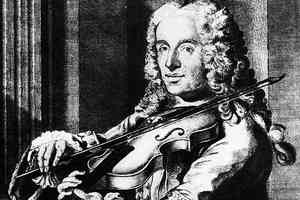
Francesco Maria Veracini 1744
Source:
Figaro
Born in 1690 in Florence, Francesco Maria Veracini was a violin virtuoso and rival as such to Pisendel and Tartini, both of whom he knew. He early inspired Tartini who recognized in Veracini what he himself yet had some practicing to do to attain. Between Veracini and Pisendel, however, there was apparently to be little love lost. Veracini composed above three dozen chamber sonatas in addition to numerous works for voice or orchestra. IMSLP has him down for only four operas, one more than others tend to credit him. Veracini was taught violin mostly by his uncle, Antonio Veracini. His father ran a music school established by his grandfather. His family also ran a painting studio, owning several expensive works as art collectors. Relevantly, it was during the Baroque that musicians came to rely less on nobility for patronage, as during the medieval and Renaissance periods, and more on commercial enterprise, particularly notable in the construction of theatres to sell seats for opera. Though Veracini would take part in the building of a theatre, that wasn't a commercial enterprise, but the project of one of the most powerful nobles in Europe whom one could win for a patron, Augustus III of Poland (Prince at the time).
A contemporary of composer and violinist, Carlo Ambrogio Lonati, Veracini's first known solo violin performance was a Christmas mass at San Marco in 1711. Exactly what violins Veracini employed at that early date I've not identified, but he favored a couple of Stainers, one which he named Peter, the other Paul [Cristo Raul]. Among the earliest prominent luthiers of the modern violin had been the Amati family, making instruments in Cremona, Italy, since the mid 16th century beginning with Andrea (c 1506-1577). Among the earliest existing Amati instruments possibly dates from 1558 made for the 1559 wedding of Philip II of Spain to Elisabeth of Valois. A collection of 38 Amatis exist which were purchased by Catherine de Medici for the coronation of her son, King Charles IX, in 1560, these bearing Charles' coat of arms. The bowed instrument, however, considerably predates Amati's modern violin, descending as far back as the rebab in the 7th century, an Arabic or Persian instrument which versions had spread everywhere that music was played as far as Java in Indonesia. The rebab came to be designed variously depending on where it got modified but its earliest shape was basically a spike fiddle of two or three strings with an elongated neck attached to a body variously large to diminished. Strings might be made of silk, horse hair or brass. The ravanahatha made with bamboo in India and Sri Lanka possibly arrived as early as the 7th century as well. Famous to Mongolia is the morin khuur, the horse-head fiddle or lute of about 1200 AD. Arriving earlier, however, was the Byzantine lyra, a bowed instrument probably inspired by the pandura, the Greek lute designed as early as the 4th century B.C.. The Byzantine lyra may have arrived as early as the 9th century, making it the bowed instrument of the early medieval period preceding the rebec of latter medieval Europe anticipating the four-string violin of the Renaissance about mid 16th century and the rise of the Amanti luthiers. References for bow instruments [1].
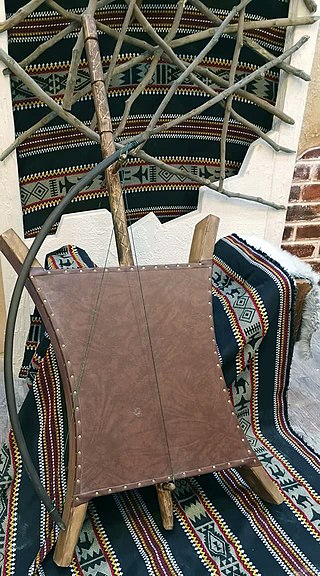
Exemplar Rebab of Yemen
Modern rebab spiked fiddle built by Muhammad al-Qadasi
Date of original unknown
Source: Wikipedia
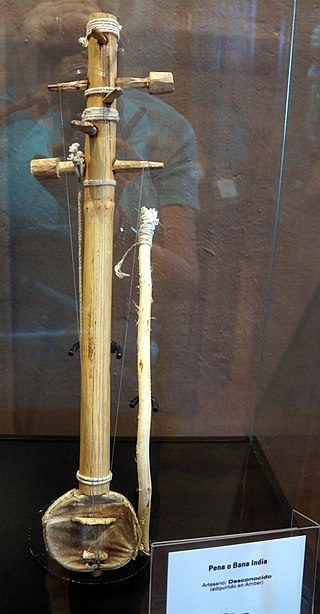
Exemplar Ravanahatha
Bamboo spiked fiddle of India Date unknown
Source: Wikipedia
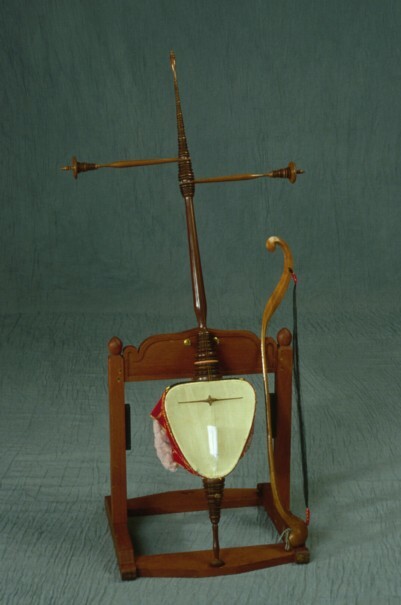
Exemplar Rebab of Java
Spiked fiddle date unknown
Source: Grinnell College
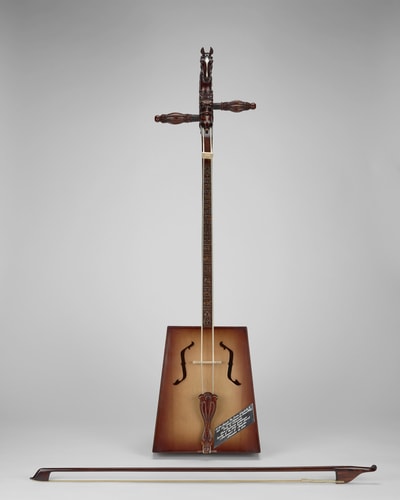
Exemplar Morin Khuur of Mongolia
Spiked fiddle c 1200
Source: Royal Collection Trust
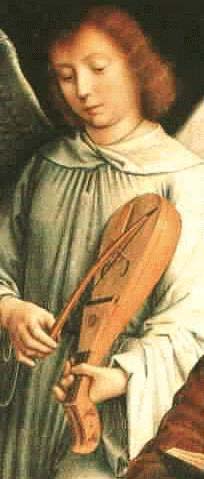
Exemplar Late Medieval Rebec
From 'Virgin Among Virgins'
Netherlandish painter Girard David c 1509
Source: Wikipedia
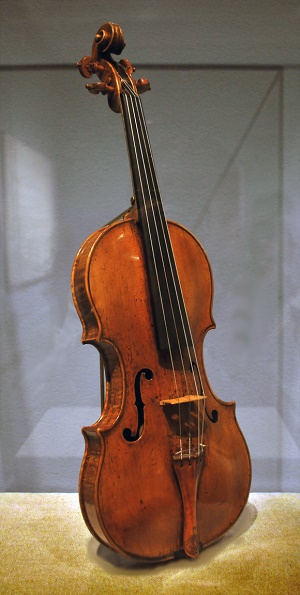
Early Amati Modern Violin
Suggested to 1558 for the 1559 wedding of Philip II of Spain to Elisabeth of Valois
Source: Wikipedia
The Stainer violin to which Veracini was partial was first made by Jacob Stainer (1617–1683), an Austrian luthier whose violin was the treasure to own before the more powerful design of the Stradivari. Veracini would become acquainted with newly made Stradivaris, yet preferred his older Stainers, one reason probably that violins are like liquor, improving with age. The Stradivarius is easily the most famous violin brand of Veracini's and later periods, commencing with Antonio (1644-1747). The Guaneris were another major family of violin craftsmen, commencing in Cremona with Andrea (1698-1744) who had been apprenticed to Amanti. Veracini is thought to have used a Guaneri violin. Yet another highly regarded craftsman of the violin family of instruments during Veracini's time was Carlo Bergonzi (1683-1747). References for luthiers [2].
IMSLP has Veracini down for several oratorios, the first of which is 'Sara in Egitto' to which he contributed an aria along with multiple others in 1708, the music for which is since lost. The first known performance of one of Veracini's own compositions was a violin concerto in 1712 in Venice. In 1714 Veracini left for London where he performed during opera intermissions at the Queen's Theatre, England's major venue. The Queen's Theatre would become the King's Theatre that year upon Queen Anne, last of the Stuarts, being succeeded by King George I, first of the Hanover line. The King's Theatre it would remain until Queen Victoria, last of the Hanovers, succeeded William IV in 1837 making it the Queen's Theatre again.
In 1717 Veracini acquired the patronage of Elector of Saxony, Prince Friedrich August of Poland, as a result of dedicating both a set of twelve sonatas and a collection of six overtures to him in 1716. Veracini's salary under August is said to have been unusually high. Becoming engaged in the project of building a new opera theatre for August at the Zwinger palace in Dresden, Veracini went to Venice to recruit vocalists in 1719. His second collection of sonatas, Op 1, was published in 1721.
'Overture No.1 in B-flat major' 1 of 6 Francesco Maria Veracini 1716
Musica Antiqua Köln / Reinhard Goebel
'Sonate a violino solo e basso' Op 1 Nos.1-7 of 12 Francesco Maria Veracini 1721
Violin: Enrico Casazza
Though the incident wants clarity, in 1722 Veracini leapt from a second-story window in Dresden resulting in either a broken foot, leg or hip that left him with a limp the rest of his life. How that transpired is told variously, but Veracini reputedly owned an arrogant personality which caused some degree of enmity between himself and other musicians, including Pisendel said to be at the source of this mysterious event. Just why or how it went down I'll not hazard amidst widely differing accounts, but the incident probably helped persuade Veracini toward less stressful employment in a church in Florence the next year.
In 1733 Veracini returned to London to compose and perform opera, his first, 'Adriano in Siria', premiering at the King's Theatre in London on 26 November 1735.
'Se mai piagato a morte' Aria by Francesco Maria Veracini
'If ever plagued to death'
From Act II of the opera 'Adriano in Siria'
Premiere: King's Theatre in London 26 November 1735
Libretto: Angelo Maria Cori after Pietro Metastasio
Europa Galante / Fabio Biondi
Veracini's final opera, 'Rosalinda', was performed in London in 1744. He also published his third set of twelve sonatas, Op 2, in 1744 dedicated to Augustus. Upon his return to the continent in 1745 he was involved in a shipwreck that claimed all his property including his two Peter and Paul Stainer violins. I've not discovered with what he replaced them.
'Sonate accademiche' Op 2 No.5 in G minor of 12 Francesco Maria Veracini 1744
Clavicembalo: Marco Mencoboni Violin: Luigi Mangiocavallo Violincello: Claudio Ronco
'Sonate accademiche' Op 2 No.12 in D minor of 12 Francesco Maria Veracini 1744
Harpsichord: Lars Urlik Mortensen Violin: John Holloway
Veracini published his pedagogical volume, 'Il trionfo della pratica musicale' ('The Triumph of Musical Practice') Opus 3 about 1750. He delivered concerts in Pisa until 1750 when he moved to Turin until 1755, then returned to his birthplace, Florence, where he died on 31 October 1768, working as maestro di capella at both San Pancrazio and San Gaetano.
Sources & References for Francesco Maria Veracini:
James Reel (All Music)
VF History (notes)
Audio of Veracini:
Classical Archives Muziek Web Naxos Presto
Bow Instruments ^ (antecedent to the modern violin / chronological):
The Rebab (Arabic or Persian 7th century):
Met Museum (Algerian or Moroccan)
The Ravanahatha (India 7th century or later):
Medieval Early: the Byzantine Lyra (poss 9th century):
The Morin Khuur (Mongolia c 1200):
Medieval Late: the Rebec (13th century):
Modern (Renaissance / begin Amati c 1550):
Case Western Reserve University
Compositions / Works: IMSLP
Il trionfo della pratica musicale (The Triumph of Musical Practice / Op 3 / c 1750 / digital copies:
Internet Archive Internet Culturale ScorSer
Luthiers ^ (major makers of the early modern violin / chronological):
Amati commencing w Andrea (c 1506-1577):
Circa 1560 Circa 1566 Circa 1624
Stainer commencing w Jacob (1617–1683):
Brobst Violin Shop (c 1655)
Tarisio (c 1645 onward)
Guaneri commencing w Andrea (1626-1698):
Library of Congress (c 1730)
National Public Radio (c 1741 / value $18 million)
Tarisio (c 1715-22 onward)
Stradivari commencing w Antonio (1644-1747):
Tarisio (c 1665-70 onward)
Wikipedia (ownership of numerous 1666 to 1711)
Bergonzi commencing w Carlo (1683-1747):
John Dilworth (Part 1)
John Dilworth (Part 2)
The Strad (c 1720)
Tarisio (c 1715 onward)
Recordings of Veracini: Catalogs:
DAHR (shellac) Discogs Hyperion Music Brainz
Recordings of Veracini: Select:
Veracini: Adriano in Siria / Europa Galante / Fabio Biondi / Austria / 2014:
Veracini: Dissertazioni sopra l'Opera Quinta del Corelli / Federico Guglielmo w Andrea Coen / 2005:
Veracini Overtures / Musica Antiqua Köln / Reinhard Goebel / Brilliant Classics / 1993:
Scores / Sheet Music:
IMSLP Internet Archive Musicalics (vendor) ScorSer
Adriano in Siria (opera 1735)
Further Reading:
Guitar: Oldest
Musical instruments: Oldest
Violin: History:
Bibliography:
John Walter Hill / The Life and Works of Francesco Maria Veracini / UMI Research Press / 1974
Authority Search (VIAF)
Other Profiles:
David Mason Greene (Greene's Biographical Encyclopedia of Composers / Doubleday / 1985)
Classical Main Menu Modern Recording
hmrproject (at) aol (dot) com